The All-Inclusive Guide to AI-Driven Ecommerce Product Recommendations
AI-driven Ecommerce product recommendations are everywhere.
They can increase sales and improve the customer experience, which makes them essential to a thriving Ecommerce business.
In this article, we’ll uncover:
- How AI-driven Product Recommendation Engines work
- Where to place recommendations in your store
- Best practices to maximize impact
Let’s jump in.
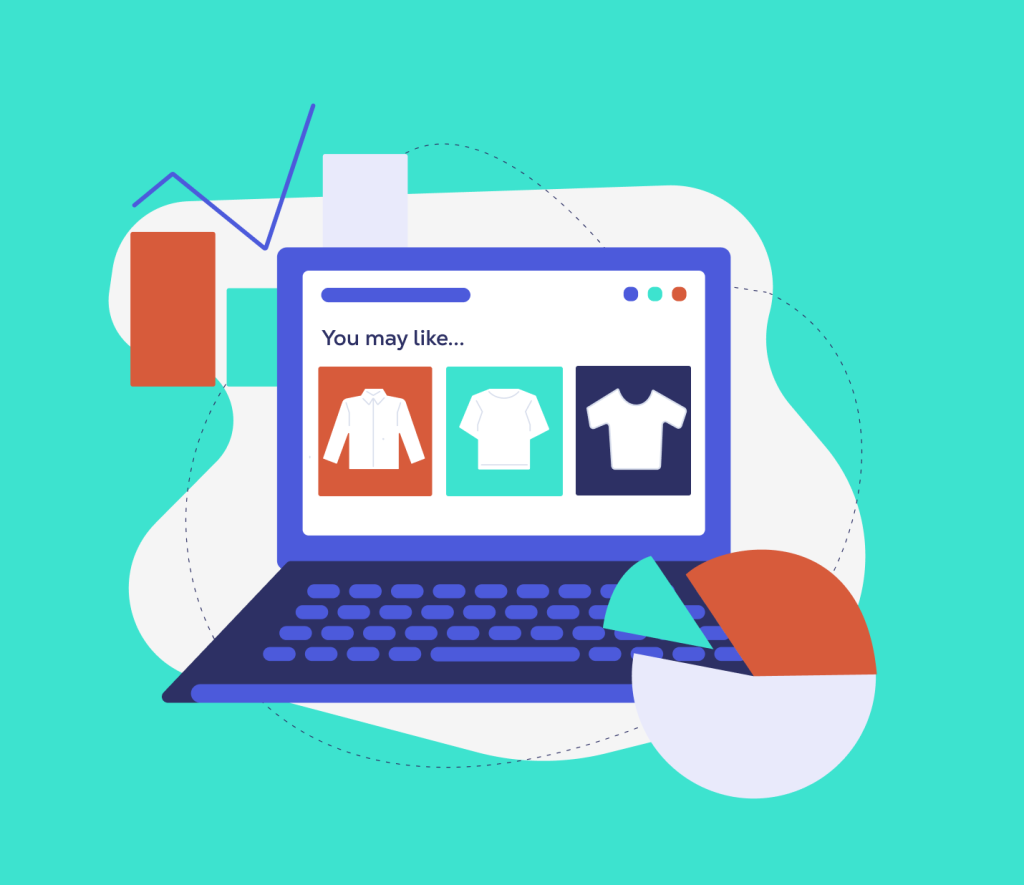
- What are AI-Driven Ecommerce Product Recommendation Engines?
- How do AI-Driven Ecommerce Product Recommendations Work?
- Benefits of Ecommerce Product Recommendations
- Strategically Placing Ecommerce Product Recommendations
- How Can You Assess If Your Product Recommendation Strategy is Successful?
- 6 Strategies to Maximize the Impact of Product Recommendations in Ecommerce
- 1. Leverage all paths to conversion, not just cross-selling and upselling
- 2. Ensure personalized product recommendations are data-driven
- 3. Strategically place product recommendations throughout your store
- 4. Create Category Pages for specific audiences
- 5. Use merchandizing to your advantage
- 6. Optimize your recommendations by running A/B tests
- What factors should you consider when choosing a product recommendation solution?
- Conclusion
What are AI-Driven Ecommerce Product Recommendation Engines?
Ecommerce Product Recommendation Engines display relevant product recommendations to shoppers throughout their journey. To do this, AI algorithms identify patterns in customer behavior to place shoppers into groups and automatically recommend products that match their preferences or are similar to what they’re viewing.
Product Recommendation engines that leverage AI to return data-driven results are the best way to help shoppers discover relevant products. This increases engagement, strengthens customer loyalty, and boosts revenue.
Thanks to recent advances in AI and GPT technologies, recommendation engines are becoming faster, more accurate, and more effective. They are a crucial tool for anyone running an online business.
How do AI-Driven Ecommerce Product Recommendations Work?
Ecommerce Product Recommendation Engines use machine learning and advanced AI-based algorithms to collect data, analyze shoppers’ behavior, and return relevant product suggestions.
They recognize shoppers’ habits, preferences, and browsing history and effectively return personalized recommendations for products they want to buy.
We’ve outlined how AI-based recommendation engine technology works to help you use it to your advantage.
Collaborative Filtering
The most common way to personalize recommendations is with collaborative filtering.
Collaborative filtering is a recommendation system that analyzes customer tastes, preferences, and browsing history to predict what they might want to buy next. The logic is simple. If Shopper A and Shopper B like the same product, then Shopper A might be interested in a product Shopper B has previously purchased.
This system identifies meaningful associations between items and users to provide accurate product recommendations for products they may not have sought out.
You need an abundance of user data for this method to be effective. Without sufficient data and rich customer profiles, recommendations may miss the mark and create a poor perception of your Ecommerce business.
There are two types of collaborative filters you should implement in your store. Let’s take a look at them.
User-Based Collaborative Filtering
User-based collaborative filtering analyzes user behavior to identify similar groups of shoppers and recommend products to those with corresponding purchase habits.
As individual customers navigate your store and make purchases, an algorithm collects that data to calculate a similarity score. Customers with matching similarity scores are then grouped together and provided with similar recommendations.
This approach assumes past users with similar preferences can help determine what similar shoppers will want in the future.
By creating rich customer profiles and accounting for changing user behavior, user-based collaborative filtering effectively tailors recommendations that align with shoppers’ tastes and preferences.
Item-Based Collaborative Filtering
Item-based collaborative filtering analyzes the relationship between types of products rather than users. This method identifies products frequently purchased together and groups them accordingly to make recommendations.
For example, in a Consumer Electronics store, this filtering system will recognize that users often buy cell phones and cases together. The next time a shopper searches for a cell phone, they will see a recommendation for the highest-rated phone cases.
Item-based collaborative filtering is most effective in stores with large product catalogs. The more items there are, the easier it is to determine relationships between them to ensure recommendations are relevant and effective.
Content-Based Filtering
Content-based filtering makes recommendations by taking a product’s attributes, related keywords, and categories into consideration. This method uses keyword-based recommendation algorithms to determine which products best suit users based on their previous activity.
Tools like Prompt Vibes can assist in refining keyword-based recommendation algorithms by generating and optimizing relevant prompts tailored to enhance the accuracy of content-based filtering systems. This ensures that product recommendations resonate better with the shoppers’ preferences.
For example, in a Health and Beauty store, content-based filters will look at a shopper’s purchase history and identify products with similar ingredients, formulas, and certifications.
Content-based filtering is most effective in stores with rich product attributes listed in their catalogs. This filtering method is an effective way to recommend items that align with shoppers’ preferences while providing insights that help better target ads and promotions in your store.
Hybrid Recommendation Systems
Hybrid Recommendation Systems leverage two or more filtering methods to suggest products that encourage catalog discovery and inspire sales.
For example, online stores can implement both content-based and user-based filtering systems (or any other combination) to provide recommendations to shoppers.
Implementing more than one type of recommendation system in your store is the most effective way to improve recommendation accuracy and relevancy.
There are different ways to approach hybrid recommendation filtering. You can use one of these AI-based recommendation techniques to modify or enhance another or combine the outputs of both filtering systems into one long recommendation list.
Next, let’s take a look at how product recommendations can benefit your store.
Benefits of Ecommerce Product Recommendations
AI-driven product recommendations engines are a powerful tool that offer Ecommerce retailers countless benefits. Here are a few of them.
Better Understand Your Customers
Product Recommendation engines leverage AI and data mining to identify meaningful connections between shoppers and products.
Advanced algorithms collect purchase history, browsing habits, ratings, reviews, search activity, and more to create comprehensive profiles of shoppers and return accurate results.
This invaluable data helps you understand your customers’ preferences and interests, which is key to effectively tailoring store offerings to meet shoppers’ needs.
Improved User Experience
If shoppers can’t quickly find the products they’re looking for, chances are they’ll leave your site and go to a competitor’s.
Providing personalized recommendations that align with shopper intent improves the user experience and keeps visitors engaged. By using AI-based personalization techniques and strategically placing relevant product suggestions throughout your store, retailers can save shoppers time and energy, encourage product discovery, and prevent frustration.
Creating a positive personalized shopping experience that makes customers feel understood will help build trust and inspire them to return.
Higher Customer Engagement
Users have very short attention spans. Placing relevant recommendations at every phase of the shopping journey will catch their attention, keep them engaged, and encourage them to spend more time on your site.
When customers are offered personalized recommendations, they are more likely to return for follow-up visits and less likely to compare prices elsewhere – leading us to our next key benefit.
Increase Average Order Value and Online Revenue
Personalized recommendations have proven to play a significant role in boosting revenue.
Data-driven recommendations that reflect changing user behavior can alert shoppers to relevant products, deals, and promotions and inspire them to explore your catalog.
When visitors see items tailored to their tastes and preferences, they are more likely to make a purchase.
As you can see, AI-driven product recommendations benefit shoppers and businesses alike.
Next, let’s look at where you should place them for maximum impact.
Strategically Placing Ecommerce Product Recommendations
Recommendations should appear seamlessly in your store to enhance the shopping experience, not overtake it. As shoppers search, browse, and add items to their baskets, recommendation types should meet shoppers where they are on their journey and help guide them through it.
Let’s look at how and where Ecommerce websites should place AI-driven product recommendations to increase engagement and shorten the path to purchase.
Search Engine Results Pages
Over 30% of visitors go directly to the search box upon entering an online store. Therefore, encouraging product discovery via Autocomplete search and on Search Engine Results Pages is lucrative and essential.
When a shopper navigates to a search results page, you can assist with their discovery by placing popular products, complementary products, or related product recommendations below the SERP results.
Keep in mind that good Ecommerce search result page design is crucial. Placing recommendations in a visible location on the search page is the most effective way to increase conversion rate.These items can help shoppers refine search intent, explore similar products, and stay in the purchase flow.
Homepages
Data-driven recommendations can help kick-start the shopping journey from the get-go.
For first-time shoppers, we suggest showcasing trending, seasonal, discounted, or new products from the biggest brands on your home page. These recommendations can entice first-time shoppers to explore the products you want to promote.
For repeat customers, personalized recommendations that align with their past preferences, browsing history, and purchase history can help them pick up where they left off. They will also show them you understand what they’re looking for.
For example, products a shopper recently viewed or discounted items that match previous user behavior can work wonders. Take a look at how Selsey recommends personalized products on their homepage.
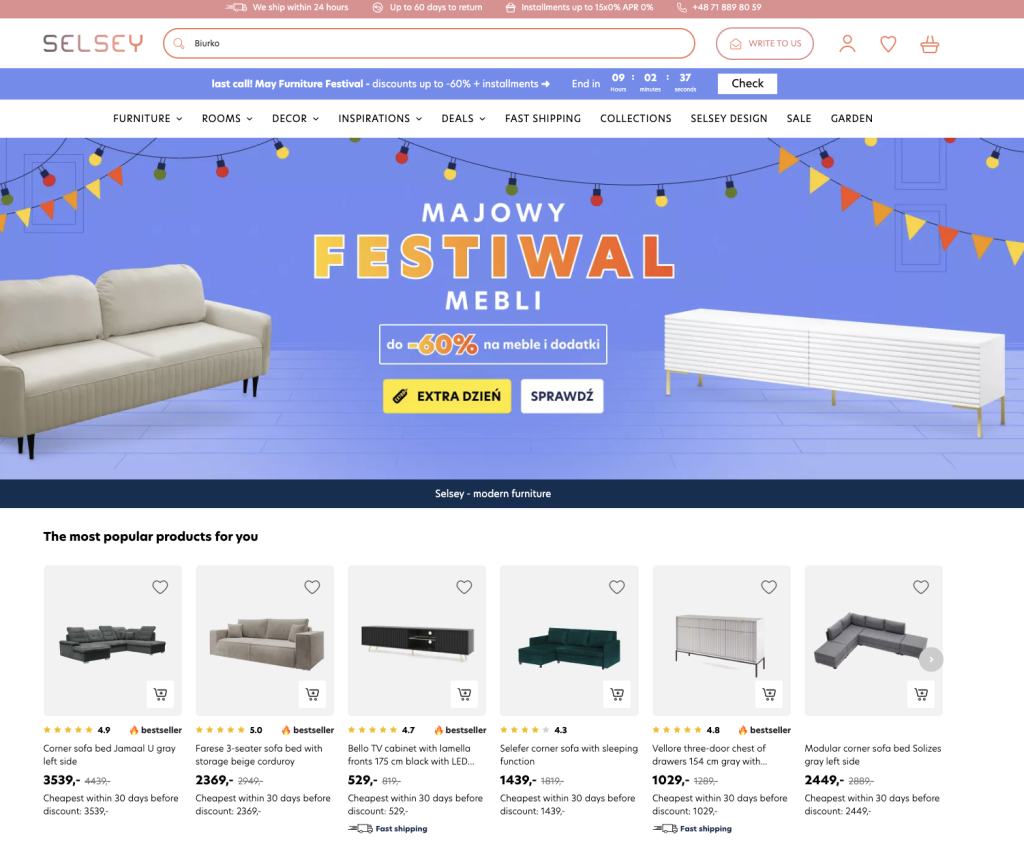
The homepage offers prime recommendation real estate to highlight products, improve the user experience, and boost sales. Be sure to implement some of the practices listed above to maximize your store’s potential.
Category Pages
Category pages showcase the most relevant items within a given product category. If a shopper searches for a microwave in Autocomplete, your recommendation engine should make it easy to navigate to a category page displaying the most popular options in stock.
Placing relevant products, such as a microwave with a grill or new models offered by a well-known brand on a specific category page can help shoppers quickly find items they want and may not have otherwise seen.
Product Detail Pages
Use the space at the bottom of the product page to your advantage.
If a shopper has decided the item they’re reviewing is not for them, you can keep them engaged by showing similar products in your catalog. Or, if they’ve added the item to their cart, you can encourage additional purchases to help them round out their order.
If a visitor is looking at a laptop, recommend other popular models at the bottom of the page. Once they add the laptop to their cart, suggest complementary items like a mouse or keyboard.
Product detail pages are a prime location to keep shoppers engaged, encourage further product discovery, and boost average order value.
Checkout Pages
If a shopper has decided to buy an item in your store, that’s great! But their purchase journey doesn’t have to end there. You can increase average order value by upselling or cross-selling relevant items on the checkout page.
Offering advanced models with a bigger profit margin or data-driven recommendations for frequently purchased together products can help with your bottom line.
Suggesting products you know a shopper will be interested in can inspire last-minute purchases at the most critical decision-making point.
Zero Result Search Pages
Shoppers expect to find desired products immediately. Therefore, unsuccessful product searches are one of the most frustrating experiences users can have in your store. If they land on a zero result research page, you risk losing them to a competitor.
That said, placing recommendations on the zero result pages can help ease the pain. We recommend checking out these no result page examples for Ecommerce and implementing the best practices.
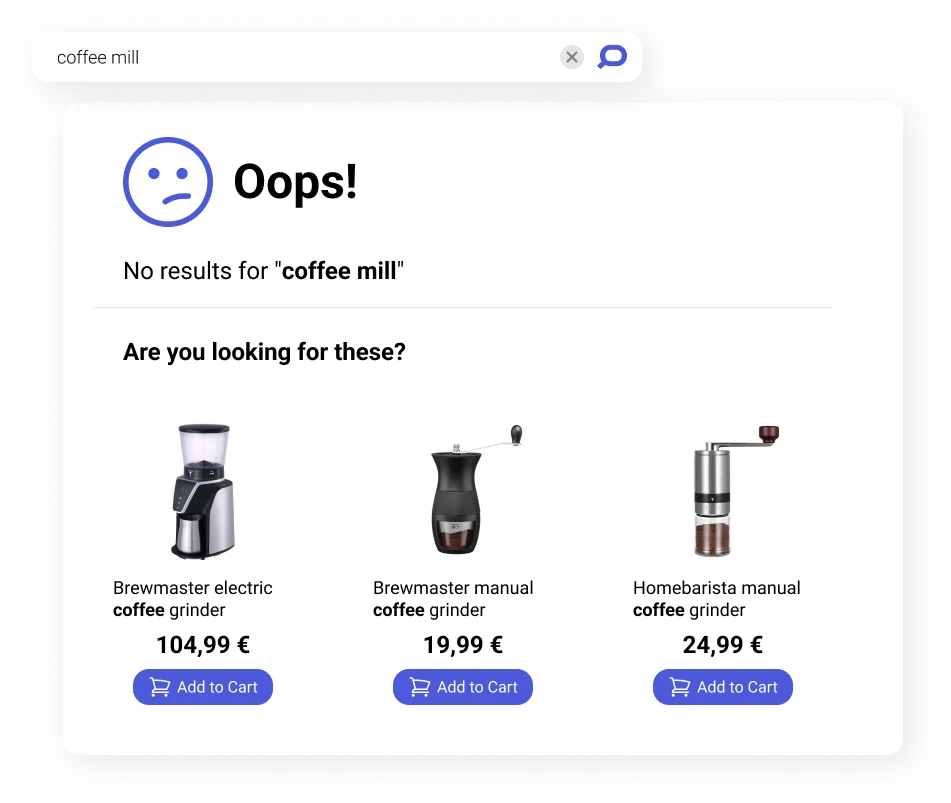
Suggesting products that align with a customer’s intent can show you understand them and make it easy for them to stay in the purchase flow.
404 Pages
404 pages, also known as “error pages” or “page not found” pages, are a bummer that can reflect poorly on your business. Conversely, you can use them to your advantage.
Placing recommendations for popular, discounted, or personalized products on 404 pages can intrigue shoppers and create additional viewing opportunities for a wide range of products.
This will create a seamless shopping experience instead of driving shoppers away.
How Can You Assess If Your Product Recommendation Strategy is Successful?
The best way to measure success is by setting recommendation-specific Ecommerce KPIs. Here are a few examples.
- Number of product clicks
- Add to basket actions
- Product checkouts
- Unique purchases
- Product revenue
These metrics are more insightful than measuring conversion rate or average order value and can help you identify if your recommendations are effective. Customer feedback, return visits, and positive reviews can also indicate how shoppers feel about them too.
Keep in mind success is defined differently from company to company. So once you identify what you want to achieve with product recommendations, track the corresponding KPIs and measure them consistently to see if you’re achieving your goals.
6 Strategies to Maximize the Impact of Product Recommendations in Ecommerce
In the highly competitive Ecommerce industry, AI-driven product recommendations have become standard. Providing personalized suggestions enhances the experience in your store, increases the likelihood they’ll become paying customers, and drives customer retention.
However, not all product recommendations are equal.
The following tips and strategies will help you properly leverage recommendations to create a seamless shopping experience, inspire purchases, and boost revenue.
1. Leverage all paths to conversion, not just cross-selling and upselling
Using product recommendations for cross-selling related items and upselling products is an effective way to increase conversion rate, but there are other strategies too.
Offer personalized Ecommerce recommendations. Product suggestions that reflect customers’ browsing history, demographics, location, and previous purchases are more likely to drive clicks.
Don’t undermine the power of social proof. Shoppers are more likely to buy products when they see others have already purchased and liked them. Include social proof in your product recommendations by highlighting good reviews and showcasing trending products.
Recommend related products. If a shopper searches for a sofa bed, recommend the most popular items in stock that align with their initial purchase intent. For example, a u-shaped sofa bed or a corner sofa bed.
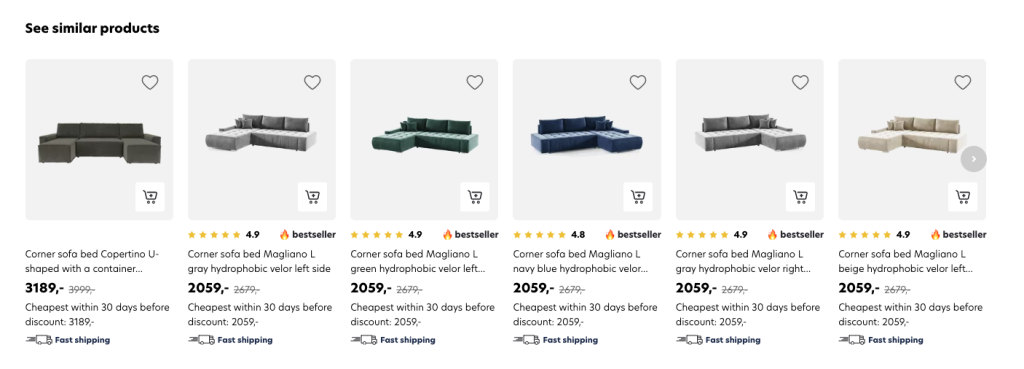
Show complementary products. If shoppers search for a video game console, recommend controllers or trending games. Encouraging shoppers to round out their purchases with related items is an effective way to drive conversions and increase average basket size.
Use scarcity. Highlighting limited-time promotions or items running out of stock with recommendations can create a sense of urgency and encourage shoppers to make faster purchase decisions.
Take advantage of E-commerce personalization and all other recommendation opportunities and use cases in your store. This will help you offer a positive customer experience that keeps shoppers coming back for more while improving your bottom line.
2. Ensure personalized product recommendations are data-driven
Recommending any old products to shoppers is not enough. Recommendations should help shoppers continue their journey effectively. One effective way to do this is by creating personalized experiences.
To create a personalized online experience, Ecommerce businesses must invest in the proper technology. AI and machine learning will analyze user behavior data to understand shoppers’ preferences and automatically return accurate product recommendations.
Recommendations that reflect customer behavior, taste, and purchase patterns are more likely to resonate with shoppers. If you want to increase conversion rate, customer satisfaction, and sales, you need to leverage the right technology to maximize the potential of your personalization efforts.
3. Strategically place product recommendations throughout your store
Item recommendations must be visible to be effective, which means placement is paramount. Offering relevant product suggestions throughout every step of the shopping journey is important. However, you must ensure the right recommendations are in the right places.
Above, we discussed the different areas you can place recommendations in your store. We also highlighted which recommendation types most effectively assist shoppers at different stages in their purchase journey.
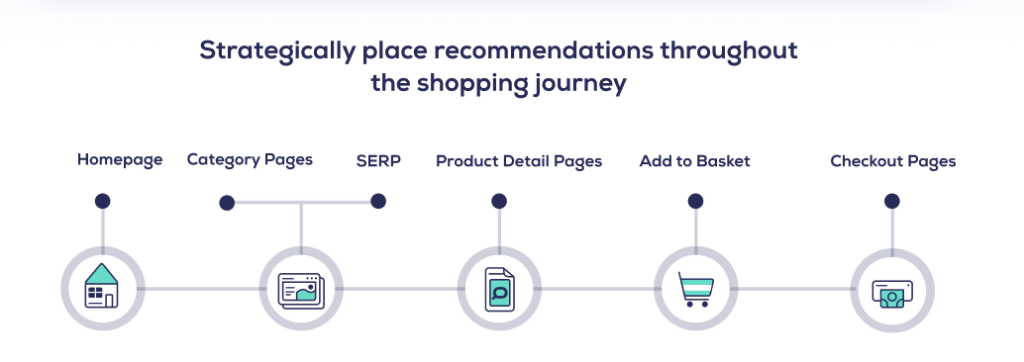
For example, related products help shoppers explore other options in your store. It’s best to offer them on the SERP, during the consideration stage where visitors browse products, rather than on a checkout page when they’ve already made a decision.
For checkout pages, complementary product recommendations are the most effective. These will allow shoppers to round out their purchases with items that align with what they’re about to buy.
Recommendations should streamline the shopping process. To create an efficient and enjoyable customer experience, you must place them strategically.
4. Create Category Pages for specific audiences
Category pages for specific audiences are unique landing pages designed for groups of users with similar tastes, interests, and shopping behavior. They help all kinds of customers navigate to the areas of your catalog most relevant to them.
You’re probably familiar with the category pages found in online fashion stores. These stores generally offer pages for men, women, and on-sale items to help shoppers quickly narrow down search intent based on their interests.
You can add more specific category pages too. For example, if someone clicks on the women’s category page in a fashion store, they can further narrow their search intent by clicking on a page for dresses. This page will show the most relevant products in the dress category and should give shoppers the ability to filter results per their desired attributes too.
In addition to being useful, category pages enable you to tailor recommendations, discounts, and promotions to the people most likely to be interested in them.
5. Use merchandizing to your advantage
Merchandizing tools allow you to promote the products you want to sell. For example, you can recommend products on sale, in high demand, or with a high-profit margin to help you improve your bottom line.
For these reasons, we recommend implementing a product recommendation solution with merchandizing capabilities that make it easy to create custom banners and campaigns. Leveraging Ecommerce merchandizing best practices in your recommendation strategy will increase product visibility and inspire shoppers to explore parts of your catalog they might not have been interested in.
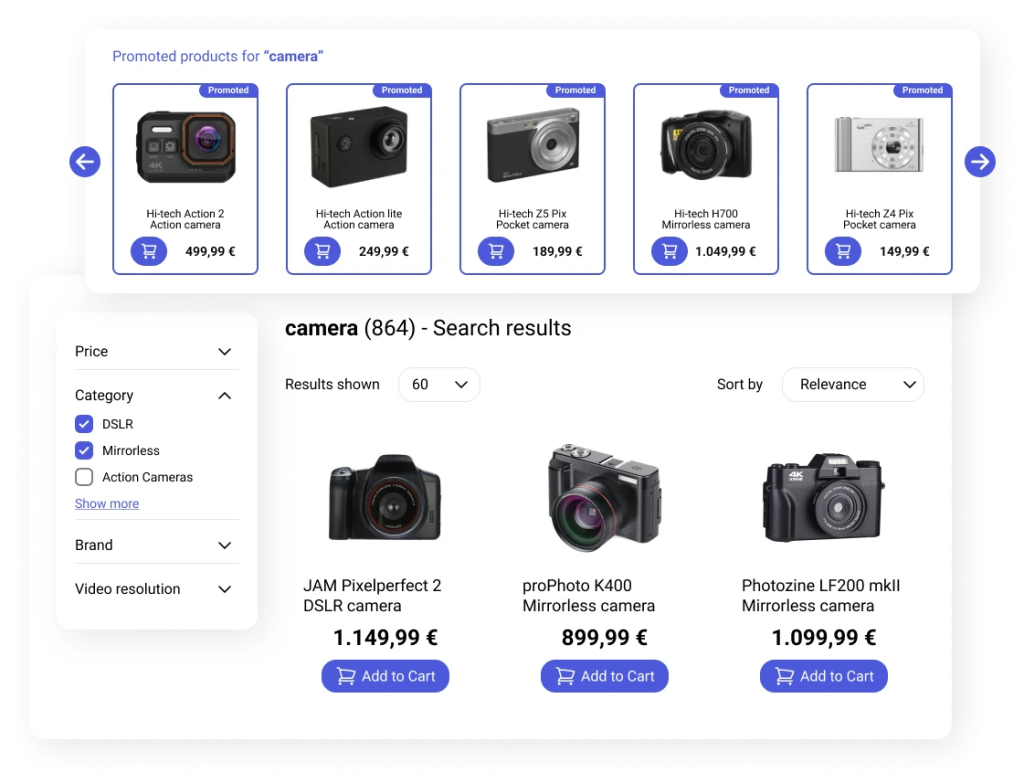
Merchandizing and searchandising (search-specific merchandizing) are powerful tools for using product recommendations to your advantage. Just make sure to keep an eye on your inventory and monitor your profit margins to ensure your promotions are financially worth your time and energy.
6. Optimize your recommendations by running A/B tests
Optimization is essential to all recommendation practices. Continuously experimenting with placement, recommendation type, and visual appearance will help you identify what recommendations are engaging your audience and where there’s room for improvement.
Incorporating A/B testing into your recommendation strategy can be time-consuming, especially if you test new ideas frequently. But this optimal approach is worth it. Dedicating the proper time and resources will help ensure your recommendations drive desired business results.
What factors should you consider when choosing a product recommendation solution?
When considering Ecommerce product recommendation vendors, it is important to consider the following criteria.
Choose a data-driven solution
As we mentioned, product recommendations must effectively guide shoppers through your store. Your solution should leverage AI, machine learning, and robust automations capable of analyzing all facets of user behavior. This will best return accurate results that meet visitors’ needs and streamline their shopping journey.
While your Ecommerce product recommendation system project may focus solely on product discovery, the best-known approach is to find an all-in-one enterprise Ecommerce search provider. Finding an AI-driven product recommendation engine is a convenient way to optimize your search and discovery with data-driven results.
Make sure it’s easy to integrate
Before investing in a product recommendation engine for Ecommerce, make sure the solution you’re interested in will integrate with your platform easily. This will save you time and money, create the best possible customer experience, and allow you to scale down the road if necessary.
Ensure recommendation settings are customizable
Every business has different needs. Therefore, your solution should be user-friendly and offer easy-to-fine-tune recommendation settings. A customizable solution will help you tailor suggestions to your shoppers and give you more control.
This is crucial to targeting specific users and customer groups with personalized products or items you want to promote. It will also allow you to adapt to changes in your industry and ensure you’re always working toward your business goals.
Pick a solution that provides detailed analytics
Detailed analytics will show you how customers interact with your recommendations. These invaluable insights will help you identify where to optimize your algorithms to better meet visitors’ needs.
Recommendation engine providers offer different analytics.
Do your research to ensure your solution tracks the metrics you need to continuously improve your solution and stand out in a crowded market.
AI-driven E-commerce Product recommendations are an invaluable tool to optimize the user experience and increase sales. The right recommendation engine can set your store up for success, so be sure to choose one that adheres to the criteria above.
Conclusion
In the current Ecommerce landscape, AI-driven Ecommerce product recommendations are essential.
Product recommendations that leverage artificial intelligence most effectively catch shoppers’ attention and shorten the path to purchase. Therefore, enabling retailers to improve the customer journey, increase conversion rates, boost sales, and build customer loyalty.
The best recommendations are data-driven by a mix of filtering methods to best meet shoppers’ needs at every point in their search. So be sure to invest in the proper technology to provide relevant suggestions in your store.
Implementing a product recommendations solution and adhering to the best practices above will help you maximize your store’s potential and be a win-win for your customers and your business.


